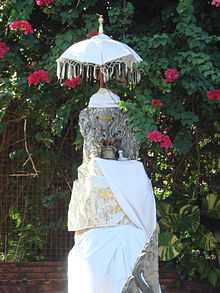Acintya
| Acintya, Tunggal Sanghyang Widhi Wasa | |
|---|---|
 | |
| Affiliation | Supreme God |
Acintya, also Atintya (Sanskrit: "the unthinkable", "the inconceivable", "he who cannot be imagined"), also Tunggal (Balinese: "Unity")[1][2] is the supreme god of Indonesian Hinduism (formally known as Agama Hindu Dharma), especially on the island of Bali. He is equivalent to the concept of Brahman, and is the Supreme God in traditional wayang (shadow puppet) theatre.[3] He is also known to most modern Balinese as Sang Hyang Widhi Wasa, also Sanghyang Widi Wasa (the "All-In-One God"), a concept introduced by Dang Hyang Dwijendra.[4]
Role

Acintya corresponds to a rather recent trend towards monism in Bali, according to which there is one supreme god, and that the other gods are only manifestations of him.[5][6] Acinthya is emptiness, and considered as the origin of the Universe, all other divinities emanating from him.[7]
He is often associated to the sun god,[8] and depicted in human form with flames around him.[9] His nakedness expresses that "his consciousness is no longer carried away by his sense-faculties".[10]
Prayers and offerings are not made directly to Acintya, but only to the other manifestations of the deity.[11] He is often not even represented, in which case he is only evoked by an empty throne on top of a pillar (the Padmasana, lit. "Lotus Throne"), inside Balinese temples.[12]
The introduction of the Padmasana as an altar to the Supreme God, was the result of a 16th-century Hindu reformation movement, led by Dang Hyang Nirartha, the priest of the Gelgel King Batu Renggong (also Waturenggong), at the time when Islam was spreading from the west through Java.[13] Dang Hyang Nirartha built temples in Bali, and added the Padmasana shrines to the temples he visited.[14]
Other View

Since the end of World War II and the Indonesian War of Independence, the Republic of Indonesia has adopted the political philosophy of Pancasila (lit. "The five principles"), which allows for freedom of religion. The statute, however, requires that the religion in question be monotheistic, i.e., based upon the belief in a single, omnipotent deity. Under this system, five religions are recognised: Islam, Buddhism, Catholicism, Protestantism and Hinduism.[15]
To comply with regulations, Balinese Hindus have felt the need to reinforce the monotheistic component of their faith, and therefore they emphasised the role of Acintya. To refer to him, they selected the term Sang Hyang Widhi Wasa ("God Almighty"), which although forged in the 1930s by Protestant missionaries to describe the Christian God, was thought to be well-adapted to describe the Hindu supreme deity.[16] This is thus the name which is now more commonly used by modern Balinese.[17]
See also
Notes
- ↑ Healing performances of Bali Angela Hobart p.151
- ↑ Dancing shadows of Bali Angela Hobart p.48
- ↑ Dancing shadows of Bali Angela Hobart p.48
- ↑ http://sejarah-puri-pemecutan.blogspot.com/2010/01/enam-tokoh-suci-dalam-perkembangan.html'', p.45
- ↑ Bali, a traveller's companion, p.45
- ↑ Bali & Lombok Lesley Reader, Lucy Ridout, p.97
- ↑ Visible and invisible realms Margaret J. Wiener p.51
- ↑ Bali, a traveller's companion, p.45
- ↑ Bali, a traveller's companion, p.46
- ↑ Healing performances of Bali Angela Hobart p.151
- ↑ Bali, a traveller's companion, p.46
- ↑ Bali and Lombok, p.26
- ↑ Bali and Lombok, p.46-47
- ↑ Eiseman, p.266
- ↑ Eiseman, p.38-39
- ↑ Eiseman, p.38-39
- ↑ Bali, a traveller's companion, p.45
References
- http://sejarah-puri-pemecutan.blogspot.com/2010/01/enam-tokoh-suci-dalam-perkembangan.html
- Bali and Lombok, 2001, Dorling Kindersley Limited, London ISBN 978-0-7566-2878-9
- Fred B. Eiseman Jr 1990 Bali. Sekala and Niskala Periplus Editions ISBN 0-945971-03-6